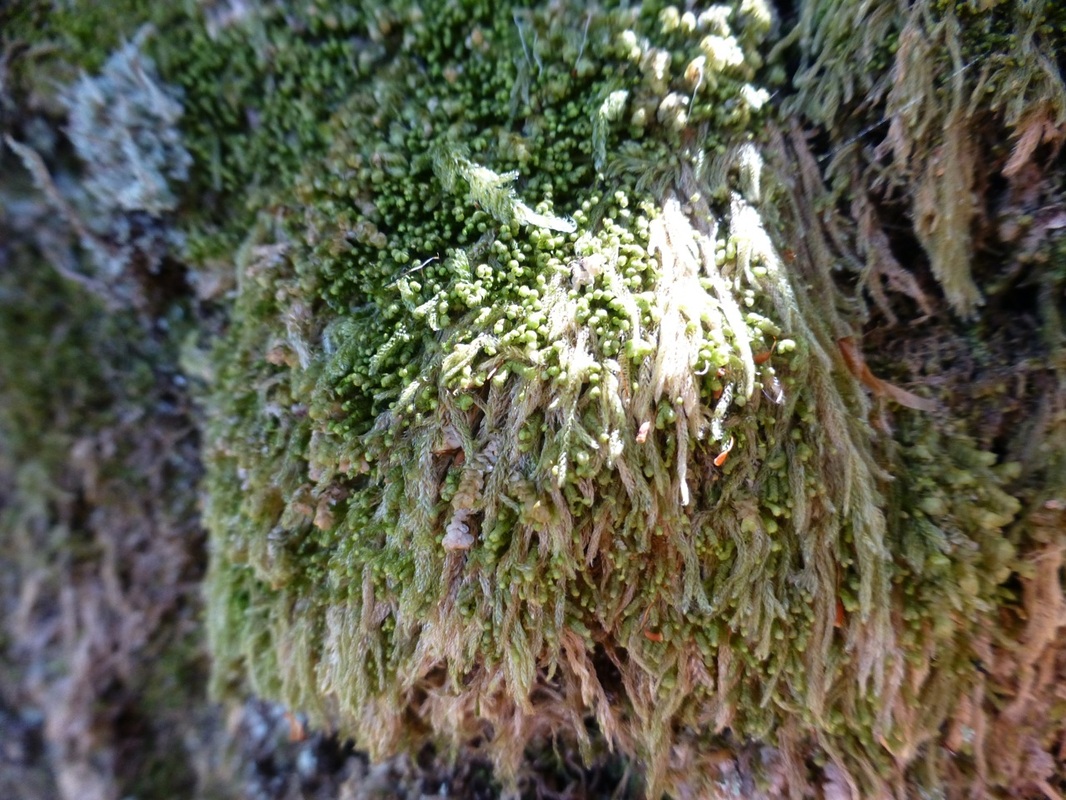Coiled-leaf moss, coiled-leaf claw-moss • Hypnum circinale
{Hypnum = derived from a Greek word for sleep; circinale = reference to the curved leaves}
Identification
Coiled-leaf moss is light brownish-green to whitish-green and moderately glossy. Its plants are slender and irregularly branched. The leaves curve strongly to one side, don't have a midrib, and have a broad base that narrows to a pointed tip. The reddish-brown sporophytes are common in winter and spring; they have long stalks that grow from the side of the stem. Hanging coiled-leaf moss tends to have a braided appearance.
Habitat & Range
Coiled-leaf moss is a common species in humid forests; it forms creeping or hanging mats on decomposing logs, tree trunks, humus, and rocks. It is a common species is low elevation rainforests, and is found to subalpine elevations. Its range extends from southeastern Alaska south to California and east to Montana.
Similar Species
Cat-tail moss (Isothecium myosuroides) also has slender irregularly branched plants that form hanging mats, but its leaves have well-developed midribs and do not curl. Curly hypnum (Hypnum subimponens) has very similar leaves to coiled-leaf moss, but is regularly pinnately branched.
Coiled-leaf moss is light brownish-green to whitish-green and moderately glossy. Its plants are slender and irregularly branched. The leaves curve strongly to one side, don't have a midrib, and have a broad base that narrows to a pointed tip. The reddish-brown sporophytes are common in winter and spring; they have long stalks that grow from the side of the stem. Hanging coiled-leaf moss tends to have a braided appearance.
Habitat & Range
Coiled-leaf moss is a common species in humid forests; it forms creeping or hanging mats on decomposing logs, tree trunks, humus, and rocks. It is a common species is low elevation rainforests, and is found to subalpine elevations. Its range extends from southeastern Alaska south to California and east to Montana.
Similar Species
Cat-tail moss (Isothecium myosuroides) also has slender irregularly branched plants that form hanging mats, but its leaves have well-developed midribs and do not curl. Curly hypnum (Hypnum subimponens) has very similar leaves to coiled-leaf moss, but is regularly pinnately branched.
References
Ellis, S. Hypnum circinale. Introduction to Bryophytes. Biology 321, Department of Biology, University of British Columbia, Vancouver. Accessed 08/09/2014.
Hypnum circinale Hook. In Klinkenberg, Brian. (Ed.). E-Flora BC: Electronic Atlas of the Plants of British Columbia. Lab for Advanced Spatial Analysis, Department of Geography, University of British Columbia, Vancouver. Accessed 08/09/2014.
Pojar, J. and MacKinnon, A. (1994). Plants of Coastal British Columbia. Vancouver, BC: Lone Pine Publishing. P. 469.
Authors and editors of page
Kelly Fretwell, Ian Cruickshank, and Brian Starzomski (2014).
Ellis, S. Hypnum circinale. Introduction to Bryophytes. Biology 321, Department of Biology, University of British Columbia, Vancouver. Accessed 08/09/2014.
Hypnum circinale Hook. In Klinkenberg, Brian. (Ed.). E-Flora BC: Electronic Atlas of the Plants of British Columbia. Lab for Advanced Spatial Analysis, Department of Geography, University of British Columbia, Vancouver. Accessed 08/09/2014.
Pojar, J. and MacKinnon, A. (1994). Plants of Coastal British Columbia. Vancouver, BC: Lone Pine Publishing. P. 469.
Authors and editors of page
Kelly Fretwell, Ian Cruickshank, and Brian Starzomski (2014).




